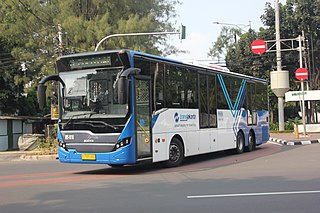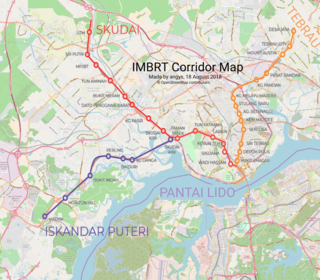
Dar es Salaam is the largest city and financial hub of Tanzania. It is also the capital of Dar es Salaam Region. With a population of over six million people, Dar es Salaam is the largest city in East Africa and the sixth-largest in Africa. Located on the Swahili coast, Dar es Salaam is an important economic centre and is one of the fastest-growing cities in the world.
Transport in Tanzania includes road, rail, air and maritime networks. The road network is 86,472 kilometres (53,731 mi) long, of which 12,786 kilometres (7,945 mi) is classified as trunk road and 21,105 kilometres (13,114 mi) as regional road. The rail network consists of 3,682 kilometres (2,288 mi) of track. Commuter rail service is in Dar es Salaam only. There are 28 airports, with Julius Nyerere International being the largest and the busiest. Ferries connect Mainland Tanzania with the islands of Zanzibar. Several other ferries are active on the countries' rivers and lakes.
Dart or DART may refer to:

Bus rapid transit (BRT), also referred to as a busway or transitway, is a bus-based public transport system designed to have much more capacity, reliability and other quality features than a conventional bus system. Typically, a BRT system includes roadways that are dedicated to buses, and gives priority to buses at intersections where buses may interact with other traffic; alongside design features to reduce delays caused by passengers boarding or leaving buses, or paying fares. BRT aims to combine the capacity and speed of a light rail transit (LRT) or mass rapid transit (MRT) system with the flexibility, lower cost and simplicity of a bus system.

Kariakoo is an administrative ward of the Ilala Municipical Council of the Dar es Salaam Region in Tanzania. Jangwani ward and Mchafukoge ward form the ward's northern and eastern boundaries. The Gerezani and Mchikichini wards border the ward on the south and west, respectively. The ward is the home of the Simba Sports Club. The name derives from the swahilization of the British colonial occupation's "Carrier Corps", that used to be based in the area. Today, Kariakoo is mainly known for its large market, that spans several city blocks. According to the 2012 census, the ward has a population of 13,780.
STRABAG SE is an Austrian construction company based in Spittal an der Drau, Austria, with its headquarters in Vienna. It is the largest construction company in Austria and one of the largest construction companies in Europe. The company is active in its home markets Austria and Germany and in all countries of Central, Eastern and South-East Europe, in selected markets in Western Europe, on the Arabian Peninsula, as well as in Canada, Chile, China and India. In these markets STRABAG has subsidiaries or operates on a project-basis.

Ilala District, officially the Ilala Municipal Council is one of five districts of the Dar es Salaam Region of Tanzania. The district is bordered to the north and northeast by Kinondoni District and Ubungo District, to the east by the Zanzibar Channel, the west by Pwani Region, and to the south by the Temeke District. It covers an area of 364.9 km2 (140.9 sq mi). The district is comparable in size to the land area of U.S Virgin Islands. The administrative seat is Mchafukoge. The 2012 National Tanzania Census states the population for Ilala as 1,220,611.

Dala dala are minibus share taxis in Tanzania. These converted trucks and minibuses are the primary public transportation system in the country. While the name originates from the English word "dollar", they are also referred to as thumni.

The Iskandar Malaysia Bus Rapid Transit (IMBRT) is a proposed bus rapid transit system to be built in and around Iskandar Malaysia, Johor, Malaysia. It will consist of trunk, direct, and feeder bus rapid transit corridors.
Chennai BRTS was a bus rapid transit system taken up as an integrated part of Circular Corridor Project in India. Beginning at Adyar, the route will cover Saidapet, Jafferkanpet, Ramavaram, Puzhal, Manali, Chennai Central Railway Station, Lighthouse and will return to Adyar. The corridor will cover a distance of 70.3 kilometres (43.7 mi). The route of the elevated BRTS corridor was planned to run along the banks of Adyar river and Buckingham canal. The project was expected to be completed by 2013.
The Lagos Bus Rapid Transit System, also known as Lagos BRT, is a bus rapid transit system in Lagos State. It is regulated by LAMATA and currently operated by Primero Transport Services Limited.

The Cebu Bus Rapid Transit System is a mass transit system under construction in Cebu City, Philippines. It is expected to become the first operational bus rapid transit project in the Philippines. Only one line has been planned in detail so far, but scheme developers note the potential to develop a larger network comprising the adjacent cities of Lapu-Lapu, Mandaue, and Talisay, all of which, together with Cebu City, form part of the Cebu metropolitan area.

Nyerere Bridge also unofficially known as Kigamboni Bridge is a 680-meter-long bridge located in the Dar es Salaam Region of Tanzania that connects the Temeke District's ward of Kurasini from the east to the west of Kigamboni District's Vijibweni ward across the Kurasini estuary. Construction work began in February 2012 and completed in April 2016.
Bhopal BRTS is a bus rapid transit system in Bhopal, located in the state of Madhya Pradesh, India. The construction was funded by the Central Government under its flagship JnNURM. Unlike most of BRT projects in India which are designed to cater the transportation needs of suburban parts of the city, Bhopal BRTS is designed mainly to serve the Central business districts (CBDs). It was launched with a fleet of just 30 buses in 2006, after receiving JnNURM Sanction, and has grown to 225 buses comprising AC and Non AC Low Floor Buses.

The Dar es Salaam commuter rail, informally known as Treni ya Mwakyembe, is an urban and suburban commuter rail network serving the Tanzanian commercial city of Dar es Salaam. It is one of the two initiatives taken by the government to ease travel within the congested city; the other being the Dar es Salaam bus rapid transit system. Services are provided by the Tanzania-Zambia Railway Authority (TAZARA) and Tanzania Railways Limited (TRL).

The Dar Rapid Transit Agency (DART) is an executive agency of Tanzania with the mandate to establish and operate a bus rapid transit system in Dar es Salaam.

Rainbow BRTS is a bus rapid transit system in the city of Pune. The system is operated by the Pune Mahanagar Parivahan Mahamandal Limited (PMPML). The infrastructure has been developed by the Pune Municipal Corporation & Pimpri Chinchwad Municipal Corporation, Pune. The project currently envisages 113 km of dedicated bus corridors along with buses, bus stations, terminals and intelligent transit management system.
TransPeshawar or Zu Peshawar is a bus rapid transit system in Peshawar, capital of Pakistan's Khyber Pakhtunkhwa (KP) province. TransPeshawar BRT system consists of two parts: the first encompasses an east–west corridor served by 32 stations on a dedicated lane for exclusive use by buses, while the second part consists of a network of feeder routes in which buses can enter and exit the system to travel on city streets. The system was inaugurated on August 13, 2020, and is the fourth BRT system in Pakistan.

Urban rail transit in Africa has emerged as a growing form of transit due to rapid urbanization that has occurred in recent decades across the continent. Some of these transit systems are older and more developed, such as the metro in Cairo which opened in 1987. Others such as the light-rail system in Addis Ababa are much more recent, which opened in 2015. A variety of technologies are being used ranging from light-rail, bus rapid-transit, and commuter-rail etc. Africa for several decades saw minimal investment in rail infrastructure, but in recent years due to urban population growth and improved financing options, investment in rail networks has increased.














